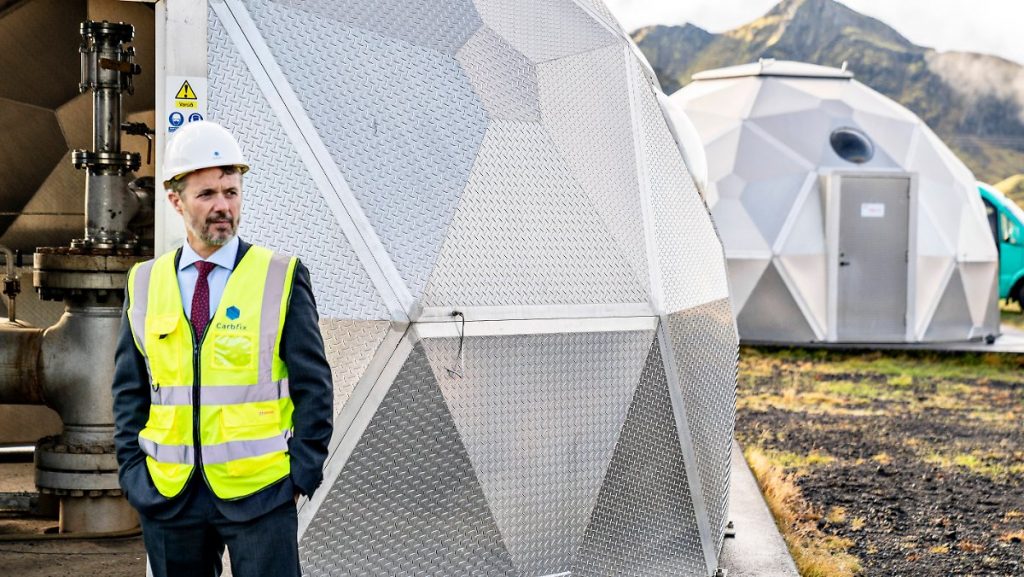Thursday 4 November 2021
Means against the climate crisis?
New technology squeezes greenhouse gases into stone
Humanity causes a lot of carbon dioxide, that’s for sure. In Iceland, engineers are currently testing a special machine that filters climate-damaging greenhouse gases from the air. The method could become a building block in the fight against climate change. But the obstacles are still great.
Turning greenhouse gases to stone: This is a promise of a new technology being tested in Iceland. As the United Nations Climate Conference in Glasgow negotiates a reduction in global greenhouse gas emissions, climate-damaging carbon dioxide is filtered from the air at the foot of the Hengel volcanic massif and trapped underground in basalt rock. Orca – “energy” in Icelandic – is the name of the system – a steel monster connected to a maze of tubes.
Work on the pilot project for Swiss start-up Climeworks with Icelandic firms Carbfix and ON Power has been underway since September. The facility, 30 kilometers from the capital, Reykjavik, is the largest of its kind in the world. Most other carbon dioxide capture projects do not capture the gas from the surrounding air, but rather capture directly from the smokestacks of polluting industries.
A large fan sucks the air into the Hengel volcano. “There is a highly selective filter in our collection containers that captures CO2 particles,” explains Swiss engineer Lukas Kaufmann, project manager at Climeworks. “Once the filter is full, we heat it up to about 100 degrees.” The pure gas obtained in this way is transported through an underground pipeline of more than three kilometers in length, dissolved in water and then compressed into the rock under high pressure at a depth of 800 to 2000 meters.
Water mixture penetrates porous basalt. There the carbon dioxide reacts with the calcium, magnesium, and iron in the stone and solidifies in the cavities into white lime crystals over the course of about two years. This method mimics the natural process of mineralization, which usually takes hundreds of thousands of years.
Very safe, but still not very effective
According to Carbfix, it is the safest form of carbon dioxide storage available today. “Carbon dioxide can only return to the atmosphere if the rocks are heated to high temperatures,” says Didier Dalmazon, professor of chemical engineering at Insta University in Paris, for example during a volcanic eruption.
Orca can store a maximum of 4,000 tons per year – very little given the billions of tons that would have to be saved to curb global warming as envisaged in the Paris Agreement. “You have to learn to walk before you can walk,” said marketing director Julie Gosalvez.
The Intergovernmental Panel on Climate Change (IPCC) advocates carbon dioxide capture and storage (CCS) as a means of mitigating climate change. Most processes aim to capture carbon dioxide as it is generated before it enters the atmosphere. However, a significant portion of carbon dioxide emissions cannot be recorded directly at the source, as is the case with aircraft, cars, and ships. Filtering these emissions from the air is the goal of the Icelandic approach.
At 0.041 percent, carbon dioxide makes up a small part of the air. Orca has to filter two million cubic meters of air to capture one ton of carbon dioxide. This makes the method very expensive, as large amounts of energy are required. Climeworks does not state exactly the cost of the process; The cost of setting up the plant alone is between 9 and 13 million euros. However, conditions in Iceland are favorable: there is enough water and most of the energy is obtained from geothermal energy. Hellisheidi geothermal power station is right next door. Carbfix is now looking into the question of whether the new method can also be used elsewhere.

“Tv expert. Hardcore creator. Extreme music fan. Lifelong twitter geek. Certified travel enthusiast. Baconaholic. Pop culture nerd. Reader. Freelance student.”





More Stories
AVL and Red Bull are developing high-tech fuel cells
Munich Oktoberfest spokesman: “Cannabis simply has no place at Oktoberfest”
The new charging method could double battery life